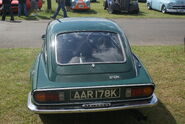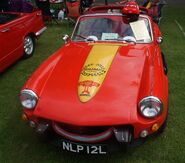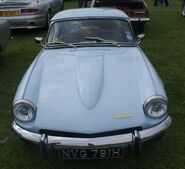
Triumph GT6 Mk 3
The GT6 was a 6-cylinder sports coupé built by Standard-Triumph and based on their popular Triumph Spitfire convertible. Production ran from 1966 to 1973.
Development history[]
In early 1963 Giovanni Michelotti was commissioned by Standard-Triumph to design a GT version of their recently introduced Spitfire 4 (also designed by Michelotti). An unmodified Spitfire 4 was transported to Michelotti's design studios in Italy and late in 1963 the prototype Spitfire GT4 was returned to England for evaluation. The styling of the vehicle was a success but unfortunately the extra weight of the GT bodyshell resulted in extremely poor performance, with the 1,147 cc (70 cu in) Spitfire power unit, and plans for producing the Spitfire GT4 were shelved.
However, Michelotti's fastback design for the Spitfire GT4 prototype was (for the 1964 season) adopted by the Triumph racing-programme as it was deemed to provide an aerodynamic benefit over the standard Spitfire body-shape. Fibreglass copies of the Spitfire GT4's fastback were grafted on to the race-modified Spitfires destined for competition. The Spitfire racing programme was successful and, in 1965, resulted in 13th overall and a 1st in class at the prestigious 24 Hours of Le Mans (beating their main rivals, the MG Midgets). The Spitfire's competitive success and the continuing commercial success of the production vehicle led Triumph to re-evaluate its shelved plans for a GT version of the Spitfire. To overcome the lack of performance inherent in the heavier body-style the Spitfire's 4-cylinder engine was replaced with the more powerful 2-litre (1,998 cc) 6-cylinder engine from the Triumph Vitesse (which shared a similar chassis with the Spitfire and Triumph Herald). The car was further developed and refined and eventually launched as the Triumph GT6 (dropping the "Spitfire" prefix) to identify its GT styling and its 6-cylinder engine.
Contemporary Triumph marketing advertised the GT6 as being developed from the "race winning Le Mans Spitfires" to capitalize on their aesthetic similarities, whereas the Le Mans Spitfires and the GT6 were actually two entirely separate development programmes (the GT programme predating the racing programme). However, the marketing spin was so successful that many people erroneously believed the Le Mans Spitfires to actually be GT6s.
The GT6 Mk I[]
The new car was introduced in 1966 and called the Triumph GT6. The new body was a sleek fastback design with an opening rear hatch (This gave the GT6 the nickname "Poor man's E-Type".). It was really a 2-seater, but a small extra rear seat could be ordered if required and was large enough for small children. The family resemblance to the Spitfire Mk II was strong, the longer 6-cylinder engine necessitated a new bonnet top with a power bulge and the doors were provided with opening quarter light windows and squared-off glass in the top rear corner. The 6-cylinder engine was tuned to develop 95 bhp (71 kW) at 5000 rpm, and produced 117 ft·lb (159 N·m) of torque at 3000 rpm. The increased power necessitated certain changes to the Spitfire mechanics; the radiator was new and mounted further forward in the car and the gearbox was the stronger unit from the Vitesse, with optional overdrive. Front springs were uprated to cope with the extra weight from the new engine. The overall vehicle weight unladed was 1,904 lb (864 kg). The interior of the GT6 was well equipped; a wooden dashboard housed a full complement of instruments, with carpets and heater included as standard.
The new car had some very strong selling points. The new engine provided a 106 mph (171 km/h) top speed and 0–60 mph in 12 seconds, a little better than the MGB GT. Moreover, the unit was comparatively smooth and tractable, in marked contrast to the MG's rather harsh 4-cylinder motor. Fuel economy was very reasonable for the period at 20mpg, and the interior well up to the competition. The only major criticism was of its rear suspension; the GT6 inherited the swing-axle system from the Spitfire, which in turn was copied from the Herald small saloon. In the saloon it was tolerated, in the little Spitfire it was not liked and in the powerful GT6 it was heavily criticised. Triumph had done nothing to improve the system for the GT6 and the tendency to break away if the driver lifted off the power mid-corner was not helped at all by the increased weight at the front of the car. The handling was most bitterly criticised in the USA, an important export market for Triumph, where they were traditionally very strong. Similar criticism was being levelled at the Vitesse saloon, which shared the GT6's engine and its handling problems.
GT6 MK II (GT6+)[]
Triumph realized that they needed to find an answer to the problem, if only to keep their reputation in the USA. Their response came with the 1969 model year, with the introduction of the GT6 MK2, known in the States as the GT6+. The rear suspension was significantly re-engineered using reversed lower wishbones and rotoflex driveshaft couplings, taming the handling and turning the Triumph into an MGB-beater. The Vitesse was also modified, but the Spitfire had to wait until 1970 for any improvements to be made.
There were other changes for the MK2: the front bumper was raised (in common with the Spitfire Mk.3) to conform to new crash regulations, necessitating a revised front end, and side vents were added to the front wings and rear pillars. Under the bonnet, the engine was uprated to develop 104 bhp (78 kW) with a new cylinder head, camshaft, and manifolds. Performance improved to 107 mph (172 km/h), but perhaps more noteworthy the 0 to 60 mph (97 km/h) time dropped to 10 seconds. The fuel economy was also improved to 25 mpg average. The interior was also updated with a new dashboard and better ventilation, a 2-speed heater fan and a black headlining. Overdrive remained a popular option for the manual transmission.
GT6 MK3[]
The final major facelift for the GT6 came in 1970, to make the MK3. This time the whole bodyshell was revised to match the changes made to the Spitfire Mk.IV; these included a cut-off rear end, recessed door handles and a smoother front end. Only detail changes were made to the mechanics, but in 1973 – close to the end of the car's life – the rear suspension was changed again, this time for the cheaper (but still effective) "swing-spring" layout also fitted to the Spitfire Mk.IV. This was a modification of the swing axle rear suspension used on the lesser Herald-derived models, with the transverse leaf spring mounted on a pivot, eliminating roll stiffness at the rear, and thus greatly reducing the jacking effect under cornering loads. To compensate for this loss of roll stiffness, a larger front anti-roll bar was fitted. A brake servo was also added in 1973, and seats were changed from vinyl to cloth. There was still a fairly comprehensive options list, but the "knock-on" wire wheels were no longer available. The unladen weight increased slightly to 2,030 lb (920 kg).
Engine power and torque for the MK3 was basically similar to the MK2, but better aerodynamics led to a new top speed of 112 mph (180 km/h) and a 0–60 time of 10.1 seconds; this was now comfortably ahead of the MGB GT, which topped out at about 105 mph (169 km/h) and reached 60 mph in approximately 13 seconds. Fuel economy was also improved to 28 mpg. The last USA models performed comparatively poorly however, as compression ratios were lowered to accommodate lower octane unleaded gasoline.
The GT6 proved to be a thoroughly pleasant, well-behaved sports car, certainly after the launch of the MK2. However it never sold in the numbers hoped for by Triumph, and was comprehensively beaten in the marketplace by the arguably inferior MGB. This seems a puzzle; the smaller-engined Spitfire sold better than the MG Midget, but this success eluded the GT6. Triumph always refused to release an official convertible version of the GT6 (although a number of owners successfully created one), and this may be partly responsible; the only likely explanation for this is their reluctance to offer any competition for their TR6 roadster, a strong seller in the USA. Whatever the reason, the GT6 was quietly dropped from the Triumph range at the end of 1973, although a few cars were sold the following year.
Today the cars have a strong following on the classic car circuit in the UK and USA. Mechanics are exceptionally strong, and share many common parts with other Triumphs of the period. Survival rate is comparatively high and there is excellent support from owners clubs.
Gallery[]
| Triumph vehicles | |
|---|---|
| Classic production cars
|
|
| Classic racecars
|
|
| Classic concept cars
|
|











